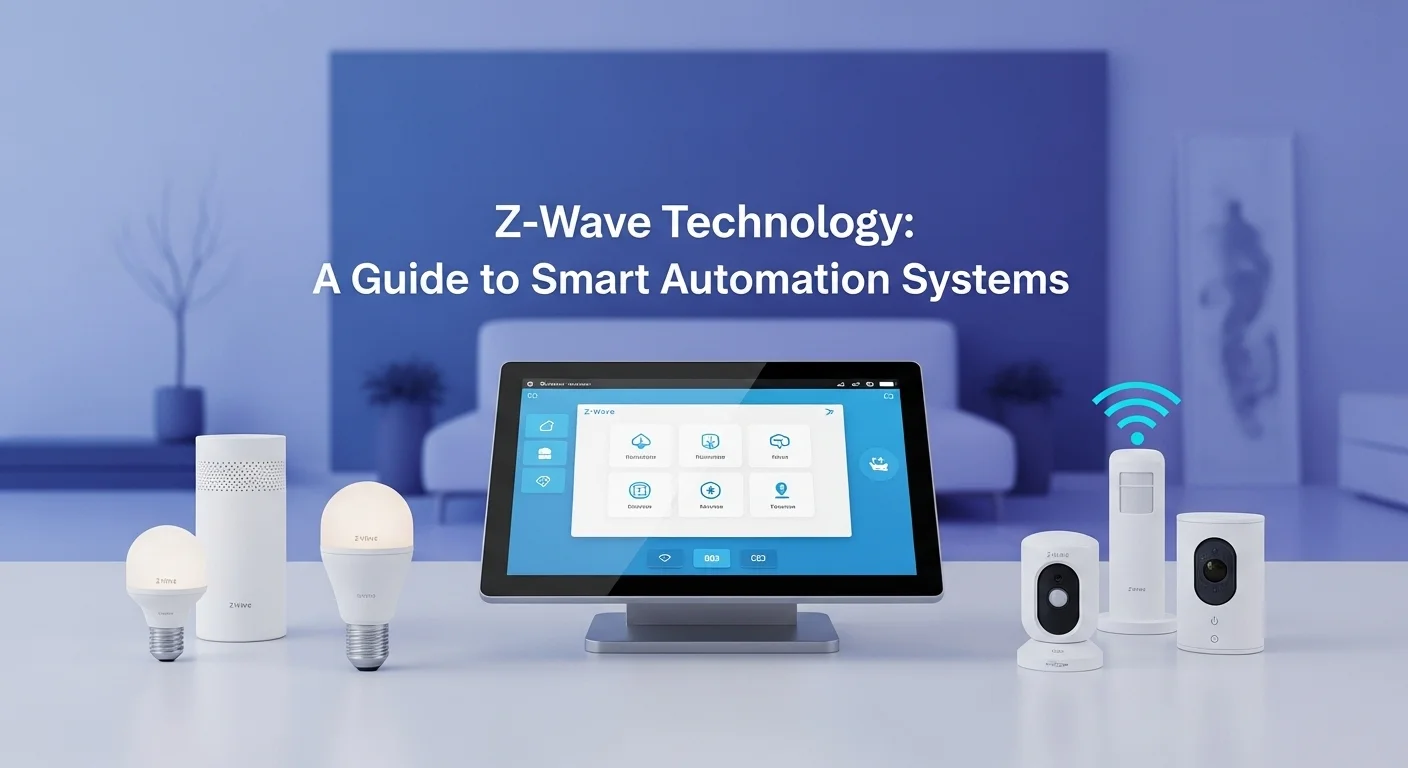Z-Wave Explained: My Personal Guide to a Truly Smart Home & Business

Executive Summary
We've all heard the promise of the 'smart home,' but let's be honest, the reality can sometimes be frustrating, with devices that don't talk to each other and unreliable connections. I've been in the trenches of home and business automation for years, and I've found that one technology consistently delivers on that promise: Z-Wave. It's the silent, reliable backbone of some of the most impressive automation systems I've ever built. Unlike Wi-Fi or Bluetooth, Z-Wave was designed from the ground up for one thing: control. In this guide, I'm going to pull back the curtain and explain it all in simple terms. We'll explore its secret weapon—the mesh network that gets stronger with every device you add. We'll look at everything from setting up your first smart light to creating a sophisticated security network with a Z-Wave intercom. We'll even see how it integrates with high-end luxury platforms like Savant and premium products like Hunter Douglas PowerView shades. By the end of this, you'll understand not just what Z-Wave is, but how to make it work for you.
Table of Contents
Table of Contents
What is Z-Wave and Why Does It Matter?
In the world of smart technology, there are a lot of competing voices. As someone who designs and installs these systems, I can tell you that Z-Wave has become my go-to standard for a reason. So, what is it? Simply put, Z-Wave is a wireless language designed specifically for smart devices to talk to each other reliably. It was created by a Danish company called Zensys way back in 1999 and is now managed by Silicon Labs. Its whole purpose is to send small, simple commands—like 'turn on light,' 'lock door,' or 'set temperature to 72 degrees'—with incredible accuracy and very little delay. It's not built for streaming movies like Wi-Fi; it's built for control, and it excels at it.
The real importance of Z-Wave, and why I trust it for my clients, comes down to how it operates. Think of it like this: Wi-Fi and Bluetooth are shouting in a very crowded room, using the 2.4 GHz frequency. Z-Wave, on the other hand, is having a clear conversation on its own private, less-crowded frequency (around 908.42 MHz in the US). This means far less interference from your microwave, cordless phones, and countless other gadgets, leading to a rock-solid network. The signal also has an easier time passing through walls and floors, which is critical in any home or business. This fundamental difference is the start of building a truly reliable and complete z wave system.
The Magic of a Self-Healing Mesh Network
Perhaps the most brilliant feature of Z-Wave, and the one I get most excited about, is its mesh network. In a typical Wi-Fi setup, every device has to connect directly to the router. If a device is too far away, it's out of luck. Z-Wave works differently. Every mains-powered device you add—like a smart light switch or a plug-in outlet—acts as a repeater. It can catch a signal from the central hub and pass it along to the next device. This means your network actually gets stronger and more reliable with every new device you add. It creates multiple paths for messages to travel, so if one path is blocked, the signal simply finds another way. This self-healing nature makes the network incredibly robust, which is essential for things you need to count on, like security sensors and door locks.
The Key Players: What Makes Up a Z-Wave System?
A typical z wave system has three key roles. First, you have the 'controller' or 'hub.' This is the brain of the operation, the central command center that manages all your devices and automation rules. It's what you interact with through an app on your phone. Second, you have 'slave devices.' These are the workers—the door sensors, motion detectors, and smart bulbs that do the actual job. Most battery-powered devices are slaves to save power. Third, you have 'routing slaves.' These are the mains-powered devices I mentioned earlier, like smart switches and plugs. They do their job (like dimming a light) while also serving as those crucial repeaters that strengthen the mesh. A huge benefit here is the Z-Wave Alliance certification. It guarantees that any certified device from any company will work with any other certified device. With over 4,000 products, this gives you incredible freedom to pick and choose the best device for the job without being locked into one brand.
Z-Wave in the Real World: Business and High-End Homes
Z-Wave isn't just for DIY home projects; its stability makes it perfect for business applications. Think about an office where lights and air conditioning automatically adjust based on whether people are in the room, saving a huge amount on energy bills. Or consider security: a business can use an integrated system with smart locks, cameras, and sensors. A z wave intercom system, for example, allows staff to remotely verify a delivery person and unlock a door, with every action logged for security records. This level of smart control brings real-world efficiency and security to any commercial space. The introduction of Z-Wave Long Range (LR) technology now allows for networks of up to 4,000 devices across a much larger area, making it ideal for large commercial buildings, hotels, and apartment complexes.
High-End Integrations: Savant and Hunter Douglas
To really see Z-Wave's versatility, you just have to look at how it's used in luxury automation. A savant z wave integration is a perfect example. Savant is a top-tier home automation brand known for its beautiful interface and powerful performance. While Savant has its own core technology, it uses Z-Wave to connect to thousands of third-party lights, locks, and sensors. This allows professional installers like me to build a dream smart home for a client, combining the elegance of Savant with the massive device library of Z-Wave. It's the best of both worlds. Another great example is the hunter douglas powerview z wave shades integration. Hunter Douglas makes beautiful, high-end motorized window shades. With a Z-Wave bridge, these shades can be integrated into the rest of the smart home. Imagine a 'Good Morning' scene that not only turns on your lights but also gently raises the blinds to let in the morning sun. This is the kind of seamless, cohesive experience that Z-Wave enables. The best z wave system is the one that fits your specific needs, whether it's a simple DIY hub or a professionally installed powerhouse like Savant. Its incredible adaptability is what makes Z-Wave a cornerstone of modern automation.

Getting Technical: A Deep Dive into Building and Securing a Z-Wave Network
Once you've decided Z-Wave is the right path, it's time to get your hands dirty. For business owners and tech professionals, knowing how to properly design and deploy a network is what separates a frustrating experience from a flawless one. Let's walk through my process for building a robust z wave system, securing it, and understanding how it compares to other technologies out there.
My Method for Building a Bulletproof Z-Wave Network
Building a Z-Wave network is a methodical process. It all starts with the controller, or hub. This is your most important choice because it determines your user experience and automation capabilities. You can go with a simple USB stick like the Aeotec Z-Stick paired with software like Home Assistant for ultimate customization, or a standalone hub like Hubitat Elevation for powerful, local control. Once you have your hub, you start the 'inclusion' process—pairing devices. The hub goes into 'add' mode, you press a button on the device, and it securely joins the network. My golden rule: build your mesh backbone first. Start by including the mains-powered devices (your repeaters) closest to the hub, then work your way out. Once that strong foundation is set, you can add your battery-powered devices. After adding a few devices, I always run a 'network heal' or 'repair' function from the hub. This tells the network to remap itself and find the most efficient communication routes. It’s like updating the GPS for your smart home signals.
Peace of Mind: Understanding Z-Wave's S2 Security
In today's world, security is non-negotiable. This is where Z-Wave's Security 2 (S2) framework truly shines. It's mandatory for all newer certified devices and provides military-grade encryption for communication, making a z wave system incredibly tough to hack. When you pair a new S2 device, you'll scan a QR code or enter a PIN. This simple step prevents a 'man-in-the-middle' attack where a hacker could try to sneak a malicious device onto your network during setup. S2 is also smart. It categorizes devices, applying the highest level of security to things like door locks and garage door openers. Unlike older security protocols that could slow the network down, S2 is lightweight and efficient, so you get top-tier security without sacrificing speed or battery life. For a business deploying a solution like a z wave intercom or access control, the S2 framework means you can be confident that your system is protected by state-of-the-art security.
The Right Tool for the Job: Z-Wave vs. The Competition
I'm often asked, 'Is Z-Wave better than Zigbee, Wi-Fi, or Bluetooth?' The honest answer is: it depends on the job. Each protocol has its strengths.
- Z-Wave vs. Zigbee: They're the closest rivals, both being low-power mesh networks for automation. The key difference I focus on is the frequency. Z-Wave’s sub-1GHz frequency gives it an edge in reliability by avoiding the crowded 2.4GHz band where Zigbee and Wi-Fi live. While Zigbee has made huge strides in interoperability with its 3.0 standard, I've historically found Z-Wave's strict certification process leads to more consistent 'it just works' experiences across different brands.
- Z-Wave vs. Wi-Fi: It's not really a competition. Wi-Fi is a data firehose, perfect for streaming video. But it's power-hungry and not a true device mesh network. A Wi-Fi door sensor's battery would die in weeks, while a Z-Wave sensor can last for years. For the small command-and-control signals of automation, Wi-Fi is overkill and inefficient.
- Z-Wave vs. Bluetooth: Bluetooth Low Energy (BLE) is fantastic for short-range connections, like your smartwatch to your phone. While Bluetooth Mesh exists, its adoption for whole-home control has been much slower and its range and ability to penetrate walls are generally less effective than Z-Wave's.
In reality, the best z wave system is often part of a home that uses multiple protocols. That's why I love modern hubs that support Z-Wave, Zigbee, and Wi-Fi, letting me pick the absolute best device for any given task.
Real-World Business Solutions
For businesses, a Z-Wave solution can be transformative. A z wave intercom is a prime example. It’s not just a doorbell; it’s an access control center. It can be integrated with smart locks and cameras, allowing staff to visually verify visitors and grant entry from a desk or even a mobile app. When that intercom is triggered, it can also set off other automations, like turning on lights in the entryway. For a truly premium feel, a savant z wave system is the answer. In a luxury hotel or corporate boardroom, the Savant platform provides an elegant interface to control an entire ecosystem of Z-Wave devices. It gives you the reliability of Z-Wave with the polished feel of a high-end control system. Likewise, integrating specialized products like motorized blinds with the hunter douglas powerview z wave bridge offers tangible benefits. In an office, you can automate shades to reduce solar heat gain, lowering cooling costs. This level of integrated control, all thanks to Z-Wave acting as the connective tissue, provides real value. For professionals, the Z-Wave Alliance website is your bible for certified products and standards, while Silicon Labs offers deep developer resources. These tools are indispensable for anyone serious about deploying successful Z-Wave solutions.

My Pro Tips for Mastering Your Z-Wave System
Getting a Z-Wave network up and running is one thing; making it truly sing is another. Over the years, I've learned a few tricks and strategies through trial and error that can take your automation from functional to fantastic. Whether you're a homeowner trying to perfect your setup or a business looking to maximize your investment, these are my go-to tips for optimizing your z wave system.
Best Practices I've Learned (Sometimes the Hard Way)
- Hub Location is Everything: Don't shove your Z-Wave hub in a basement closet next to your water heater. Place it in a central, open location in your home or office. Radio waves are physical things, and giving your hub a clear starting point makes a huge difference.
- Build Your Mesh Intentionally: I can't stress this enough. Always install your mains-powered devices (switches, plugs) first. Start near the hub and work your way out. This builds a strong communication highway before you add the battery-powered cars (sensors) that need to use it.
- Pair Devices In Place: The initial pairing is a direct conversation between the hub and the device. Try to pair the device in its final location. If you have trouble, you can bring it closer to the hub to pair, but make sure you run a 'network repair' after you move it so it can find its new, optimal route.
- Embrace Newer Generations: Z-Wave has evolved. Devices using Z-Wave Plus v2 (700 series) or the new 800 series offer better range, longer battery life, and the crucial S2 security. While everything is backward compatible, your network will be faster and more secure if it's built with modern devices.
- Banish 'Ghost' Nodes: This is a mistake I see all the time. If you remove a device, you must properly 'exclude' it from the hub first. If you just unplug it and throw it away, the hub will keep trying to talk to a device that isn't there. This 'ghost' can wreak havoc on your network, causing delays and failed commands. Regularly check for and remove failed nodes to keep your network healthy.
Unlocking a Better User Experience
- Use Direct Association, Your Secret Weapon: This is a feature many people overlook. You can 'associate' two Z-Wave devices so they talk directly to each other, no hub required. For example, you can link a wireless wall switch to a smart plug. When you press the switch, the signal goes straight to the plug—it's instantaneous and will work even if your internet is down. I use this for all critical lighting.
- Create Smart Scenes, Not Just Remote Controls: The true magic of the best z wave system is when it works for you. Don't just turn lights on and off with your phone. Create a 'Movie Night' scene that dims the lights, lowers the blinds, and locks the front door with one tap. Create an 'Away' scene that arms your security and sets back your thermostat. A smart system should anticipate your needs.
- Add Voice Control: Let's be practical. Sometimes it's just easier to say 'Hey Google, turn on the porch light' than to find your phone. Connecting your Z-Wave hub to a voice assistant is simple with most modern hubs and makes the whole system more accessible.
- Explore Multi-Tap Functions: Many Z-Wave wall switches can do more than just turn a light on or off. They can be programmed so a double-tap or triple-tap of the paddle triggers a completely different scene, like turning off all the lights on the first floor. It’s like having a secret power button.
High-Value Business Tools and Integrations
For businesses, leveraging the right integrations can be a game-changer.
- Smarter Access with a z wave intercom: A modern z wave intercom isn't just for buzzing people in. It's a full-fledged access control tool. I've set these up for businesses to generate temporary digital keys for contractors, log every entry, and allow managers to grant access from anywhere in the world, all while integrated with the main security system.
- The Luxury Experience with Savant: When a client wants the absolute best, a savant z wave integration is the answer. In a luxury hotel or boardroom, we can use the sleek Savant interface to control a complex network of Z-Wave devices for lighting, climate, and audio/video. It provides an effortless, premium experience backed by Z-Wave's rock-solid reliability.
- Ambiance and Efficiency with Smart Shades: Don't underestimate the power of light control. Using the hunter douglas powerview z wave integration, a restaurant can automatically adjust its shades throughout the day to create the perfect dining atmosphere, while an office can reduce heat from the sun to cut down on A/C costs. Integrating this into the central z wave system allows it to work in concert with lighting and climate for maximum effect.
My Go-To Resource for Further Learning
The smart home world moves fast. To stay on top of it, you need reliable sources. A resource I personally follow and recommend for unbiased reviews and excellent tutorials on Z-Wave and other protocols is the Smart Home Solver YouTube channel. They do a fantastic job of breaking down complex topics. By using these tips and staying curious, you can build a z wave system that's not just smart, but truly intelligent.
Expert Reviews & Testimonials
Sarah Johnson, Business Owner ⭐⭐⭐
The information about Z Wave is correct but I think they could add more practical examples for business owners like us.
Mike Chen, IT Consultant ⭐⭐⭐⭐
Useful article about Z Wave. It helped me better understand the topic, although some concepts could be explained more simply.
Emma Davis, Tech Expert ⭐⭐⭐⭐⭐
Excellent article! Very comprehensive on Z Wave. It helped me a lot for my specialization and I understood everything perfectly.



